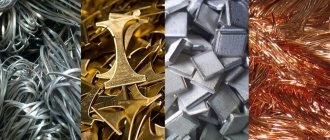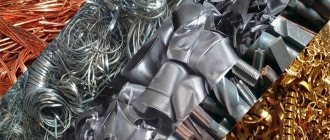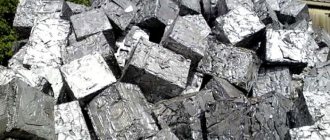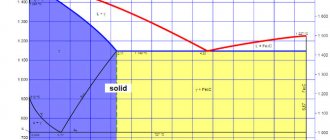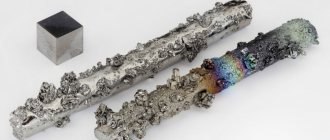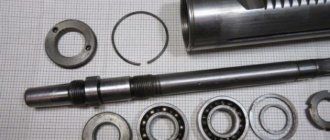Non-ferrous metals are those that do not contain iron in significant quantities. These are alloys based on copper, nickel, aluminum, magnesium, lead and zinc. Copper provides high thermal and electrical conductivity, an alloy of copper and zinc (brass) is used as an inexpensive corrosion-resistant material, an alloy of copper and tin (bronze) ensures the strength of structures.
Nickel-copper alloys have high corrosion resistance, nickel-chromium alloys have high thermal resistance, and nickel-molybdenum alloys are resistant to hydrochloric acid. Aluminum alloys have high corrosion resistance, thermal and electrical conductivity. Magnesium-based alloys are very light, but not very strong; titanium-based alloys are strong and lightweight. All these varieties of non-ferrous metals and alloys are widely used in industry, mechanical engineering, aircraft manufacturing, instrument making, and for the production of items needed in everyday life.
Non-ferrous metallurgy is a branch of heavy industry that is engaged in the extraction, enrichment and processing of non-ferrous metal ores. Non-ferrous metal ores have a very complex composition, which varies not only in different deposits, but even within the same deposit at different ore mining sites. Commonly encountered polymetallic ores consist of lead, zinc, copper, gold, silver, selenium, cadmium, bismuth and other rare metals.
The main task of non-ferrous metallurgy enterprises is to identify and separate metals, while ore can go through several dozen stages of processing. The main components can be processed on site, others - in specialized enterprises, noble, rare and trace metals are extracted from the ore in specialized plants by refining non-ferrous metals.
In the Russian Federation there are deposits of ores of almost all non-ferrous metals. Copper ores are mined mainly in the Krasnoyarsk Territory and the Urals. Aluminum is mined in the Urals, Western Siberia (Novokuznetsk), Eastern Siberia (Krasnoyarsk, Bratsk, Sayansky). Lead-zinc deposits are being developed in the North Caucasus (Sadon), Transbaikalia (Nerchinsk), and the Far East (Dalnegorsk). Magnesium ores are widely found in the Urals and Eastern Siberia. There are deposits of titanium ores in the Urals, the Kola Peninsula, and Western Siberia. Deposits of copper-nickel and oxidized nickel ores are concentrated on the Kola Peninsula (Monchegorsk, Pechenga-nickel), in Eastern Siberia (Norilsk), and in the Urals (Rezhskoye, Ufaleyskoye, Orskoye).
Currently, Russia is the leader in reserves of iron ore and nickel, and has significant reserves of titanium, platinum group metals, copper, lead, zinc, silver and other non-ferrous metals. The largest non-ferrous metallurgy enterprises are MMC Norilsk Nickel, JSC Uralelectromed, Ural Mining and Metallurgical Company, Novgorod Metallurgical Plant.
According to analysts from the INFOLine news agency, in 2007-2011 the production capacity of Russian metallurgical enterprises will increase significantly: for the production of alumina - by more than 30%, primary aluminum - by more than 25%, refined copper - by more than 35%, zinc – more than 50%.
Non-ferrous metallurgy
Non-ferrous metallurgy is a branch of heavy industry that produces construction materials. It includes mining, beneficiation of metals, redistribution of non-ferrous materials, production of alloys, rolled products, processing of secondary raw materials, as well as diamond mining. The former USSR produced 7 million tons of non-ferrous metals.
The development of scientific and technological progress requires an increase in the production of durable, ductile, corrosion-resistant, lightweight structural materials (alloys based on aluminum and titanium). They are widely used in the aviation and rocket industries, in space technology, in shipbuilding, and in the production of equipment for the chemical industry.
Copper is widely used in mechanical engineering and electrometallurgy, both in pure form and in the form of alloys - with tin (bronze), with aluminum (duralumin), with zinc (brass), with nickel (cupronickel).
Lead is used in the production of batteries, cables, and the nuclear industry.
Zinc and nickel are used in the iron and steel industry.
Tin is used in the production of tinplate and bearings.
Noble metals have high ductility, and platinum has high melting point. Therefore, they are widely used in the manufacture of jewelry and equipment. Without silver salts it is impossible to produce film and photographic film. Based on their physical properties and purpose, non-ferrous metals can be divided into 4 groups.
Classification of non-ferrous metals:
Non-ferrous metallurgy industries:
Non-ferrous metals have excellent physical properties: electrical conductivity, malleability, fusibility, the ability to form alloys, and heat capacity.
Based on the stages of the technological process, non-ferrous metallurgy is divided into:
Russia has many types of non-ferrous metals. 70% of non-ferrous metal ores are mined by open-pit mining.
The specificity of non-ferrous metal ores is:
a) in their complex composition (multicomponentity)
b) in the low content of useful components in the ore - only a few%, sometimes even a fraction of %:
To obtain 1 ton of copper concentrate, 100 tons of ore are used, 1 ton of nickel concentrate – 200 tons, tin concentrate – 300 tons.
All ores are pre-enriched at mining and processing plants and in metallurgical processing. Concentrates are produced there:
Read also: Why does the cutter shoot when cutting?
Due to significant material consumption, non-ferrous metallurgy is focused on raw material bases. Since ores of non-ferrous and rare metals have a multicomponent composition, the integrated use of raw materials is of practical importance. The integrated use of raw materials and recycling of industrial waste connects non-ferrous metallurgy with other industries. On this basis, entire industrial complexes are formed, for example, the Urals. Of particular interest is the combination of non-ferrous metallurgy and basic chemistry. When sulfur dioxide gases are used in industry, zinc and copper are produced.
- raw materials – copper, nickel, lead
- fuel and energy – titanium, magnesium, aluminum
- consumer - tin
- copper pyrites are concentrated in the Urals. Krasno Uralsk (Sverdlovsk region), Revda (Sverdlovsk region), Gai (very high metal content - 4%), Sibay, Baymak.
- copper-nickel. Galnakhskoye (northern Krasnoyarsk Territory). The Norilsk Combine is based on it
- cuprous sandstones. A promising deposit is Udokanskoye in the Chita region north of the city of Gara.
Metallurgy of heavy metals (copper, nickel, zinc, tin, lead).
Heavy metal ores are characterized by a low metal content per unit of ore.
Copper industry.
The copper industry is confined to raw material areas due to the low grades in concentrate, except for the refining of the crude metal. Main types of ores:
Copper-nickel and polymetallic ores are used as additional raw materials (copper is obtained from them in the form of matte).
Copper production is divided into 2 cycles:
Copper smelters are located at:
Urals: Krasno-Uralsk, Kirovograd, Revda, Mednogorsk, Karabash.
Kyshtym, Verkhnyaya Pyshma.
In the Urals, the recycling of industrial waste for chemical purposes is widely developed: Krasno-Uralsk, Revda. After roasting zinc and copper, sulfur dioxide gases are obtained. Based on sulfur dioxide gases, sulfuric acid is obtained, with the help of which phosphate fertilizers are produced from imported apatites of the Kola Peninsula.
Copper along with nickel is produced in Norilsk on the basis of the Tanakh deposit.
Kazakhstan. Dzhezkazgan, Kounrad, Sayak (Dzhezkazgan region), Bozshakul (in Pavlodar region).
Copper smelters – Balkhash, Dzhezkazgan. Irtyshsky in the city of Glubokoe (East Kazakhstan region) uses polymetallic and copper-nickel ores.
Uzbekistan. Almalyk – copper smelter + deposit.
Nickel-cobalt industry (nickel production).
It is closely linked to raw material sources due to the low metal content of the ore. In Russia there are two types of ores:
Lead-zinc industry.
It uses polymetallic ores. Generally confined to ore. Lead-zinc concentrates have a high content of useful components (up to 62%), and, therefore, are transportable, so beneficiation and metallurgical processing are separated from each other, unlike the copper industry. Thus, zinc production in Chelyabinsk is based on imported concentrates from Eastern Siberia and the Far East.
The lead-zinc industry is distinguished by its disposal of waste for chemical purposes. By electrolysis of a solution of zinc sulfate, sulfuric acid is obtained, which can also be produced from sulfur gases obtained by roasting zinc concentrates. Place of Birth:
Ukraine. Production of zinc from imported Sadonsky concentrates - Konstantinovka. Donbass - electricity
Kyrgyzstan. Aktyuz – mining and enrichment of polymetallic ores
Tajikistan. Kansai – ore mining and beneficiation
Tin mining industry.
The tin mining industry is divided into stages of the technological process. Metallurgical processing is not associated with sources of raw materials. It focuses on areas of consumption of finished products: Moscow, Podolsk, Kolchugino (north of the Vladimir region), St. Petersburg or located on the routes of concentrates: Novosibirsk. This is due to the fact that the extraction of raw materials is dispersed over small deposits, and concentrates are highly transportable (concentrate content is up to 70%).
Metallurgy of light metals (aluminium, titanium, magnesium).
Aluminum industry.
Aluminum production is divided into two cycles:
- obtaining alumina (aluminum oxide). At the same time, soda and cement are produced, i.e. the chemical industry is combined with the production of building materials. Alumina production, being a material-intensive production, gravitates towards raw materials.
- production of aluminum. The production of aluminum metal, being an energy-intensive production, gravitates towards sources of cheap electricity. To produce 1 ton of aluminum, 2 tons of alumina are used.
The raw materials for aluminum production are:
To produce 1 ton of alumina, you need 2 tons of bauxite, or 4-7 tons of nephelines, or 15 tons of alunites. To smelt 1 ton of aluminum, 20,000 kW/h is required.
A characteristic feature of the Russian aluminum industry is its dependence on tolling (production of primary aluminum from foreign raw materials).
Read also: Calculation of the power of a toroidal transformer by core
Azerbaijan. Alunit-Dag is now Ganja. Sumgaiti - enterprise
Titanium-magnesium industry.
Magnesium is extracted from chemical raw materials - potassium-magnesium salts. Titanium and magnesium are used in the manufacture of jet engines, spacecraft, and shipbuilding. The production of titanium and magnesium is an electricity-intensive production facility located jointly at titanium-magnesium plants.
Gold mining industry.
Russia ranks 5-6th in the world in terms of production in the world. In terms of proven reserves - 5,000 tons - Russia is second only to South Africa.
Domestic deposits are represented by crumbly, ore and complex deposits. The main reserves are concentrated in primary (complex) ore deposits. The development of crumbly deposits requires less money and time, which is why they have always been explored in the USSR, but are now being depleted. In the future, there will be production at primary deposits, which requires attracting capital.
The Russian-Australian JSC Lenzoloto was created, developing the Bodaibo mines. The Sukhoi Log field is being developed. The bulk of domestic gold is in the Far East (2/3), in Eastern Siberia (1/4), 5% in the Urals.
Diamond mining industry.
Russia annually receives $1.5 billion from the sale of diamonds. Now a large JSC AlRosa has been created.
Diamonds are mined in more than 20 countries. Some of them are independent exporters, others enter the market through intermediaries. For example, Russia – through the South African cartel “De Beers”. World production is 100 million carats, of which 50% are technical.
Domestic diamonds are located in Yakutia, for example, the Yubileinoye and Udachnoye deposits - 75% of the production of Yakut diamonds. Kimberlite pipes occur in the Arkhangelsk region, as well as in the Krasnoyarsk Territory and Irkutsk region. The northwestern part of the Russian platform is promising. There is a kimberlite field in the Arkhangelsk region. According to De Beers estimates, the reserves of one of the identified deposits are 25 million carats. Potential diamond-bearing Leningrad region and Karelia.
Since ancient times, metal has become an indispensable element in human everyday life. Thanks to it, we have the opportunity to use electricity, transport, gadgets and other benefits of civilization. That is why metallurgy can be considered a key industry in every state. Metallurgy is a branch of heavy industry that involves a lot of financial, material, energy and human resources.
Modern metallurgy has achieved significant development. Thanks to the achievements of science, we have the opportunity to use not only metals given to us by nature, but also innovative composite materials and alloys. They have improved properties and characteristics.
Classification of types of metallurgy
Smelting metals requires a colossal amount of energy and resources, so most mining enterprises work specifically to meet the needs of metallurgy.
To further study the characteristics of this industry, its main types should be highlighted. Today there are two main industries: ferrous and non-ferrous metallurgy.
Chernaya is responsible for the production of iron-based alloys. At the same time, it includes other elements such as chromium and manganese. All other production of products from other metals is called non-ferrous.
The production technology has a similar cycle, regardless of the type of raw material, and consists of several stages listed below:
- Extraction of raw materials and their processing. Most metals are not found in nature in their pure form, but are included in various ores, the processing of which is called beneficiation. During the beneficiation process, ore is crushed into small components, from which metal elements and waste rock are separated during the separation process. Alloys are produced from isolated elements.
- Redistribution The metallurgical limit is the process of manufacturing semi-finished products, which in turn are used to manufacture finished products. During the redistribution process, the composition, structure and properties of the alloys, as well as the state of aggregation, change. Processing processes include rolling and crimping, pipe production, melting and casting.
- Recycling. Most waste from metallurgical production is either disposed of or processed into other useful products. Some of the waste rock and slag is deposited in large open-air storage areas. But today, manufacturers are trying to process by-products as efficiently as possible. Some slags are reprocessed to produce additional products, some are used to produce agricultural fertilizers, but most are used to make building materials that are widely used in everyday life.
Most of the metal produced goes through the rolling stage, that is, the production of semi-finished products for the production of finished products. A similar operation is performed on a special device, which is a system of rotating rollers. Metal is passed between them, which under high pressure changes thickness, width and length.
There are cold and hot rolled products, the differences of which lie in the different temperatures of the processed raw materials. Cold rolling is used for raw materials that have a high level of plasticity, which allows the structure of the metal to be preserved and its physical properties not to change.
Read also: Table of grain size of petal circles
The rolling process is not always the final stage in the production of semi-finished products. For example, for iron and steel products, processing methods such as coating or hardening may be used. This improves corrosion resistance, increases strength and reduces wear.
It should be noted that the majority of products produced by the metallurgical industry are steel pipes. In second place are sheet and section metals used in mechanical engineering.
Among the main consumers of products in this area, it is worth highlighting the construction sector, mechanical engineering and metalworking.
At the same time, almost every sphere of the national economy cannot do without the use of metallurgical products, as well as blanks and semi-finished products from them.
Difference between non-ferrous and ferrous metals
The lack of magnetic properties is not the only difference. Below we will indicate what other differences are. So, the features of non-ferrous metal are as follows:
- it does not corrode and does not lose its properties. Of course, over time, the color of copper and zinc may change, but other characteristics will remain the same.
- the material has high anti-friction properties;
- excellent conductive functions, high thermal conductivity and heat capacity;
- difficult to paint;
- creates alloys and compounds that are resistant to fire and acids.
Non-ferrous metals are lighter in weight and more expensive in price due to reduced supply and limited resources. Industrial processing of recyclable materials allows us to solve the problem of lack of the required resource. This saves fuel, preserves the environment and ore deposits, the reserves of which are already severely depleted. In their pure form, non-ferrous metals are extremely rarely used, most often as alloys, which expands the scope of their application.
So, we have identified the main differences between non-ferrous and ferrous metals, their properties and areas of application. For more detailed information on processing and acceptance of recyclable materials for production, please contact the specialists of TsML LLC by phone. Other information on the subject of the resource is available on the corresponding page of the site.
Ferrous metallurgy
Ferrous metallurgy is based on the processing of iron, namely the ores in which it is contained. Most iron ores are natural oxides. That is why the first stage of production is the separation of iron from the oxide. Large blast furnaces are used for this. This method of producing cast iron is carried out at temperatures above 1000 degrees.
In this case, the properties of the resulting raw materials directly depend on the temperature of the blast furnace and the melting time. With further processing of cast iron, steel or foundry cast iron is obtained, with the help of which blanks and products are cast.
To produce steel, iron and carbon are used, the addition of which gives the resulting alloy the desired properties. Various alloying components can also be used to achieve certain characteristics of the steel.
There are several methods for producing steel, which are based on smelting the metal in a liquid state. The following should be highlighted: open hearth, oxygen-converter and electric melting.
Each type of steel is called a grade, which indicates its composition and properties. To change the properties of steel, an alloying method is used, that is, adding additional components to the alloy. The elements most often used for such purposes are chromium, manganese, boron, nickel, tungsten, titanium cobalt, copper and aluminum. Typically, such components are added to molten steel.
But there is another method, which consists in pressing fine-grained powder of the components and then baking at high temperatures.
Features of the composition and use of ferrous metals
Ferrous metals are those that contain iron. These include mild, carbon and stainless steel, cast iron. They are used to manufacture products for the metallurgical, food, chemical industries, construction and other areas of life, starting with multi-story buildings, using small screws for fastening.
The composition of the products is mainly dominated by iron. The material retains strength and durability after processing. Stainless steel is resistant to corrosion due to its chromium content. Most ferrous metals have magnetic properties and are successfully used in electrical engineering.
Non-ferrous metallurgy
The production of such products is not much different from ferrous metallurgy technologies. The non-ferrous metallurgy cycle also consists of ore beneficiation, metal smelting, conversion and rolling. But in some cases, refining of metals can also be used, that is, purification of the primary product from impurities.
Purification of non-ferrous metal ore is a more difficult task, since it contains much more foreign impurities, including other useful components. As in ferrous metallurgy, non-ferrous by-products are widely used in the processing industry, especially in chemical production.
Two sub-sectors should be distinguished: metallurgy of heavy and light metals. The principle of this division is based on the different properties of the non-ferrous metals being processed. The production of heavy metals requires significantly less energy.
Sometimes a third group, the so-called rare earth metals, is isolated. This name is due to the fact that previously such elements were poorly studied and were rarely found in natural conditions. Although in fact their quantity is not inferior to many heavy or light non-ferrous metals. They are usually used in the production of high-tech devices.
Products from this industry are widely used in mechanical engineering, aerospace, chemical industry and instrument making.
